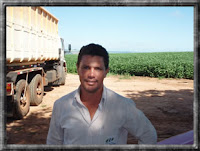 |
| Field Day | Alvarez |
 |
| Center pivot on rice | Alvarez |
 |
| Field Day | Edwin Neumann, Renan Bueno, Ervin Neumann |
Last week, I attended two rice field days hosted by Valmont and our cooperating growers in Brazil. After visiting fields in São Paolo state the previous week, we then went to Rio Grande do Sul state. I traveled with Dr. Jose Parfitt of the Embrapa Temperate Climate Research Center at Pelotas. We spent time at their research plots at Pelotas, Bage, and São Vincente. We also visited the Toniazzo and Alvarez farms near São Borja. Both fields looked great. They are fully headed, within a couple of weeks of harvest.
On Thursday, 20 January, we held a field day at the Alvarez farm. Adalberto Alvarez and his sons, Bernardo and Fernando, welcomed 150 people to view their great-looking rice field, listened to presentations by several professionals and shared a great barbeque lunch. It was a warm, sunny day and most people I saw seemed to enjoy themselves. Bernardo told me that, based on their success this year, they intend to expand the acreage of pivot rice in the future.
After a nice drive across Rio Grande do Sul, we flew back to São Paolo for a field day at Fazenda Agua Grande. Ervin Neumann and his son Edwin welcomed a much smaller, but equally enthusiastic, group of farmers to their rice field. The rice there is also close to harvest. One difference is that, unlike the cooperators in the South, the Neumann field includes two varieties, with the Querencia close to harvest; the Taim will probably take a little longer.
On Sunday, I left the warmth (32 degrees Celsius, 90 degrees Fahrenheit) and returned to the much more comfortable (0 degrees Celsius, 32 degrees Fahrenheit) High Plains of Nebraska. It is always a treat to visit Brazil; the people are beautiful, the scenery is fantastic and the food is always great. However, it was nice to get home, also. I have to admit, I did not notice any problems in Brazil trying to dig our vehicles out of snowdrifts or spinning out on the icy roads!





